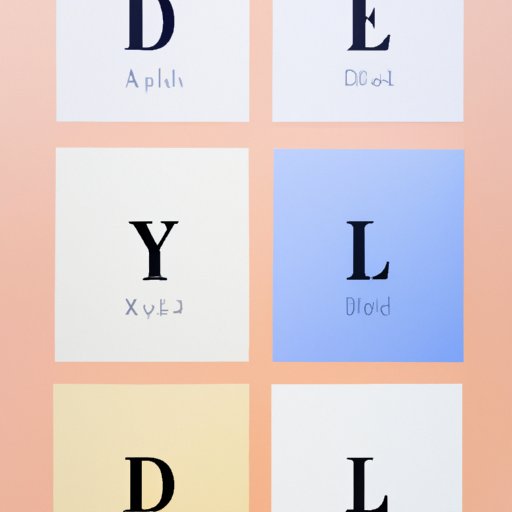
I. Introduction
Do you or your child struggle with reading and writing? Do you find simple tasks like spelling and note-taking challenging? If so, you may be suffering from dyslexia. Dyslexia is a common learning disorder that affects millions of children and adults worldwide. It can interfere with an individual’s ability to read and write, leading to a host of academic and social challenges.
In this article, we’ll explore the 10 most common symptoms of dyslexia, how they can impact learning and development, indications for early identification, and how to support those who struggle. Whether you are a parent, educator, or healthcare professional, this guide will shed light on the signs, symptoms, and effects of dyslexia.
II. 10 Common Symptoms of Dyslexia You Need to Know
Identifying dyslexia early on can help individuals receive the support they need to succeed academically and socially. Here are ten common signs that may point to this learning disorder:
- Difficulty with phonemic awareness: Difficulty distinguishing between individual sounds in speech, such as substituting or omitting sounds in words, and struggles with rhyming. For instance, your child may say ‘wirty’ instead of ‘dirty.’
- Difficulty with decoding: Unable to read words accurately and fluently, often confusing similar-looking words such as “was” and “saw.”
- Difficulty with spelling: Struggling to spell words correctly and inability to apply phonics rules. Your child may frequently misspell easy words or mix up the order of letters. For example, writing “heer” instead of “here.”
- Difficulty with reading comprehension: Struggling to understand the meaning behind what’s being read. Children with dyslexia can decode individual words independently, but have trouble reading sentences, paragraphs, or entire pages accurately.
- Dislike for reading: Children with dyslexia may avoid reading altogether, find it challenging to complete, or complain about it being too slow.
- Difficulty with writing: Struggling to translate thoughts into written words, with lower handwriting quality or inconsistent spacing.
- Difficulty with taking notes: Taking notes can be especially challenging for children with dyslexia. They may struggle to keep up during lectures and miss key information.
- Difficulty with following instructions: Dyslexic individuals may have difficulty maintaining attention, following instructions, and/or remaining organized.
- Struggles with concepts like time and direction: Difficulty telling time, using calendars or remembering left and right.
- Struggles with social situations: Struggle with face to face connection due to slower processing.
If your child or you experience several of these symptoms, they should be evaluated by a professional to determine if dyslexia is the cause of their struggles.
III. Is Your Child Struggling with Reading and Writing? It May Be Dyslexia
Reading and writing difficulties are often the first signs of dyslexia in children, making it critical for parents and educators to recognize the symptoms. Here are some ways to identify if dyslexia may be the cause of your child’s struggles:
- Early struggles: Difficulties starting in their very first stages of learning to read, write, and learn.
- Persisting difficulties: Difficulties that continue and don’t eventually disappear with practice, may point to dyslexia.
- Difficulty with sounds: Difficulty associating or recognizing the letter sounds that make up words, such as struggling with sounds in speech.
- Struggles with rhyming: Children with dyslexia may struggle with the ability to differentiate between similar sounds and have difficulty with rhyming words.
- Gaps in writing: Through all levels, capability in writing may present a significant gap with respect to age and grade level of the child.
- Difficulty with handwriting: Poor handwriting, spelling accuracy, and overall composition of essays and paragraphs are clear indications of dyslexia.
- Low sense of self: Dyslexia can weaken the self-esteem and the self-confidence that a child has in themselves because of their struggles with academic performance.
Early identification of dyslexia is essential to provide the appropriate support and tools necessary to help children overcome their challenges and self-doubts.
IV. Understanding Dyslexia: How to Recognize the Symptoms
There isn’t just one type of dyslexia. Instead, there are several types of dyslexia, and each type has its own set of signs and symptoms that can clue parents, educators, and healthcare providers to the presence of the condition. Here are the main types of dyslexia:
- Phonological Dyslexia: Individuals have difficulty identifying and processing sounds. They may have trouble translating speech sounds into letters appropriately and may avoid unfamiliar words.
- Orthographic Dyslexia: Individuals experience difficulties spelling familiar words and remembering sight words. They may also mix up letters in words that look alike or resemble one another.
- Surface Dyslexia: Individuals with this kind of dyslexia struggle with reading words by how they appear at first glance. They may struggle with irregular spelling words.
- Rapid Naming Dysfunction: Individuals have difficulty implementing the connections between symbols and ideas. They may struggle with naming objects or characters quickly.
- Mixed Dyslexia: Individuals with mixed dyslexia have a mixture of symptoms from several types of dyslexia.
If you suspect your child or you may have dyslexia, it is essential to learn how each type affects individuals. Understanding these differences can help you advocate for appropriate support and targeted therapy and tools.
V. Signs of Dyslexia in Adults: What to Look for
While dyslexia is commonly thought of as a learning disorder affecting children, it can persist into adulthood. Here are some signs to watch out for when considering dyslexia as a possible diagnosis:
- Reading difficulties: Struggles to read quickly, accurately, or without confusion. These individuals may lose their place, skip words, reread sections or avoid reading altogether.
- Directional confusion: Difficulty with understanding left and right, and trouble with telling time, leading to frequent mistakes and confusion.
- Difficulty with writing and spelling: Dyslexic adults may exhibit poor spelling, grammar, and vocabulary in emails, text messages, and other written communications. They may also have trouble writing coherently.
- Mispronunciations: Often mispronouncing words, they may struggle with pronunciation or word choice or have trouble putting their thoughts into speech coherently.
- Limited mathematics: They may exhibit difficulties with concept, sequencing and numbers. This could be reflected in matters involving math, finances and timelines.
- Idea association processing slow: As such they may struggle with personal anecdotes and storytelling in general.
It is vital to recognize and address dyslexia among adults to provide them with the necessary support to succeed academically and professionally.
VI. Dyslexia Symptoms: How They Affect Learning and Development
Learning and development are essential elements in any individual’s educational and personal growth. Here’s how dyslexia can impact a child’s learning and development:
- Low sense of self: Children with dyslexia face constant academic challenges that may cause them to feel inadequate in comparison to their peers. It can also lead to low-self-esteem and diminished motivation.
- Learning delays: Dyslexia can cause learning problems and make it difficult or impossible to keep up with the pace set by their peers and academics.
- Social challenges: Dyslexic children may also have difficulty connecting with their peers through shared interests, extracurricular or sporting activities, and may exhibit lower social skills and have fewer friends than correlated with their age average.
- Career prospects: If not diagnosed early and appropriately due to the contents of dyslexia, it can cause an impact due to various psychological factors, and academic insufficiency can lead to a lack of confidence and hesitance to pursue their desired career.
- Emotional distress: Dyslexia can create feelings of anxiety, frustration, and shame. This can significantly impair their emotional well-being and growth as neglected impact to emotional well-being can progress toward mental illness.
- Decreased motivation: Over time, constant struggling with academic performance can dampen the fighter spirits of the individual causing them to lose their natural desire to strive for academic and personal excellence.
Understanding the impact of dyslexia on development can help parents and educators to identify areas that an individual requires more support and lead them in a more inclusive environment.

VII. The Hidden Symptoms of Dyslexia: Beyond Difficulty Reading and Writing
Reading and writing difficulties are the most common signs of dyslexia, but they aren’t the only ones. Here are some lesser-known symptoms to be aware of:
- Difficulty with executive function: Executive function includes abilities such as attention control, strategic planning, work organization, and multi-tasking. Dyslexic individuals may have difficulty with these areas too.
- Difficulty with fine motor skills: Even though dyslexia is a language-based disorder, it can affect an individual’s fine motor skills, resulting in poor handwriting and difficulty with intricate tasks such as art and crafts.
- Difficulty with balance and coordination: About 30% of people with dyslexia may experience balance and coordination issues. These issues may be linked to poor motor control and difficulties with spatial awareness.
- Migraines: Individuals with dyslexia are more likely to experience migraines and may be more susceptible to visual stressors.
- Phonemic sensitivity and pitch perception: Phonemic sensitivity is the ability to recognize and identify individual speech sounds in words. People with dyslexia struggle with this skill, and it is linked with pitch perception difficulties.
Recognizing all the symptoms of dyslexia is essential in an accurate diagnosis and intervention strategy.
VIII. Recognizing Dyslexia in Children: Early Identification is Crucial
The primary advantage of early detection is that it allows for targeted intervention that speeds up the process of overcoming dyslexia. However, dyslexia can be challenging to spot in children, particularly during the preschool and early primary stages due to the rapid changes observed in early development.




